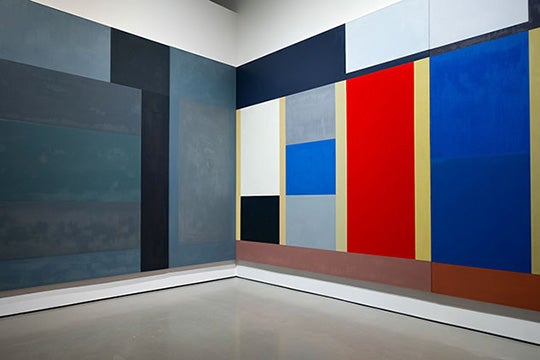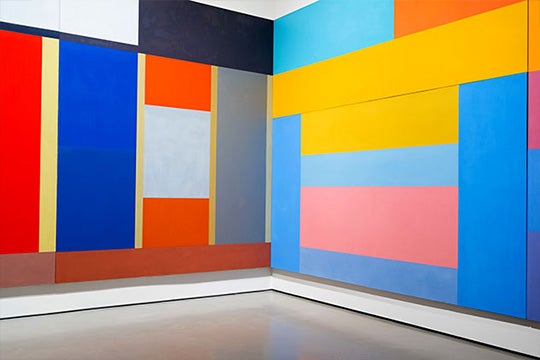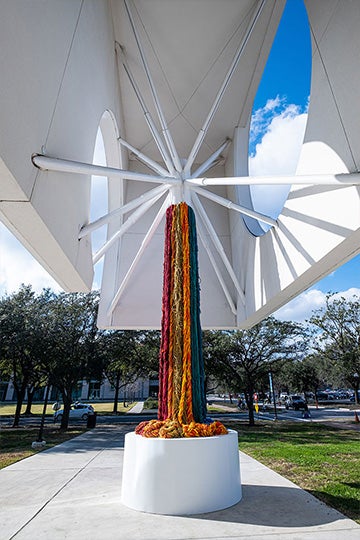
Remembering Rothko
The Moody Center for the Arts celebrates the 50th anniversary of the Rothko Chapel.
By Katharine Shilcutt
Founded by John and Dominique de Menil and opened in 1971, the Rothko Chapel houses 14 of artist Mark Rothko’s famously color-saturated pieces and is one of Houston’s most iconic landmarks. In celebration of the chapel’s half-century anniversary, the Moody Center for the Arts has organized a unique exhibition that brings together the chapel’s past, present and future, highlighting the extraordinary impact the landmark monument has had on both artists and the public since its creation.

“Artists and the Rothko Chapel: 50 Years of Inspiration,” which opened Feb. 16 and closes May 15, is an undertaking nearly two years in the making that features the work of Sam Gilliam, Sheila Hicks, Shirazeh Houshiary, Byron Kim, Brice Marden and David Novros — all contemporary artists influenced by the Montrose landmark.
“This project both celebrates the history of the arts at Rice and highlights our long-standing connections to the cultural life of Houston,” said Alison Weaver, the Suzanne Deal Booth Executive Director of the Moody Center. When the Moody team realized the 50th anniversary of the Rothko Chapel was approaching, she said, “we wanted to explore the extraordinary impact the chapel has had on artists from diverse backgrounds, working in a wide range of media.”
Past and Future
Organized in two sections, the first part restages the 1975 exhibition “Marden, Novros, Rothko: Painting in the Age of Actuality” that was organized by Harris Rosenstein and supported by Dominique de Menil, then director of the Institute for the Arts at Rice, and originally staged in Rice’s now-demolished Art Barn. The restaged exhibition at the Moody is the first time the works by Marden and Novros have been reunited since 1975, recreating the immersive experience that viewers had upon first seeing them installed at Rice.

The second section of the exhibition looks to the future, highlighting works by contemporary artists of diverse ages, nationalities and backgrounds as a means of exploring the wide-reaching influence of the nondenominational chapel.
Organizing this multifaceted exhibition was no small task for associate curator Frauke Josenhans. For one, not only had Marden and Novros’ works ended up in separate collections across Texas, from the Menil to the Modern Art Museum of Fort Worth, the panels themselves are massive on their own, even more so when they’re reunited. “These are really monumental works,” Josenhans said. “And that explains why most of them haven’t been shown in decades — because they’re very complicated to install. It’s almost like a big, chromatic puzzle.” But the impression upon completion, hung on equally giant walls custom-built for the occasion, is stupendous. Walking into each of the three “rooms” created by the paintings creates an immersion in color.
“That’s how David [Novros] describes them — how he wanted them to be seen and experienced,” Josenhans said. “It’s very similar to when you walk into a medieval church in Italy, and suddenly you find yourself surrounded by early 15th-century Renaissance frescoes — color is everywhere, and color is the binding element that creates this very immersive environment.”
Rothko’s Legacy

In the Central Gallery, the work of contemporary artists engage color with similar intensity: The great disruptor of Color School painting, Sam Gilliam, at age 87, demonstrates new techniques in pyramidal sculptures created last year for an exhibition at Pace Gallery in New York. They sit adjacent to some of Gilliam’s monumental washi paper paintings on the walls, in a conversation of sorts.
“The Questioning Column,” a rainbow-hued work by 84-year-old textile artist Sheila Hicks, is draped from the Moody’s towering oculus outside, while a stunningly intricate piece by Shirazeh Houshiary, who works across such diverse media as sculpture, video installations and architecture, greets visitors at the Moody’s main entrance: a vibrant red painting that looks like both a distant nebula and the inner workings of a human blood vessel.

Works by Byron Kim, this season’s Leslie and Brad Bucher Artist-in-Residence at the Moody, round out the exhibition — including new paintings created specifically for this show. Kim presents paintings that evoke the ocean in all its temperaments in one gallery. In another gallery, larger-scale works depict the bruise-colored night sky over his Brooklyn studio.
A catalog, available in May from Yale University Press, will include new installation images, interviews and contributions by the artists alongside testimonies by local figures reflecting on the interconnectedness of the Rothko Chapel and the arts at Rice.
Pulling together a show like this would be feat enough under non-pandemic conditions. It would have been easy, Josenhans said, for anyone involved to say “sorry, no” at any point along the way. But the way the artistic community has come together to create something of this scale has been inspiring, she said — and totally in keeping with the Rothko’s mission. “Everyone was extremely supportive, from the artists to the institutions,” she said. “Everyone really stepped up.”
And after nearly two years of work, it’s all come together at last. “The Rothko Chapel is a place that brings people together,” Josenhans said. “And I think that is also the spirit that we tried to convey in this exhibition.”
“Artists and the Rothko Chapel: 50 Years of Inspiration” is on view at the Moody Center for the Arts from Feb. 16 to May 15. The Moody is free and open to the public. For more information, visit moody.rice.edu.
